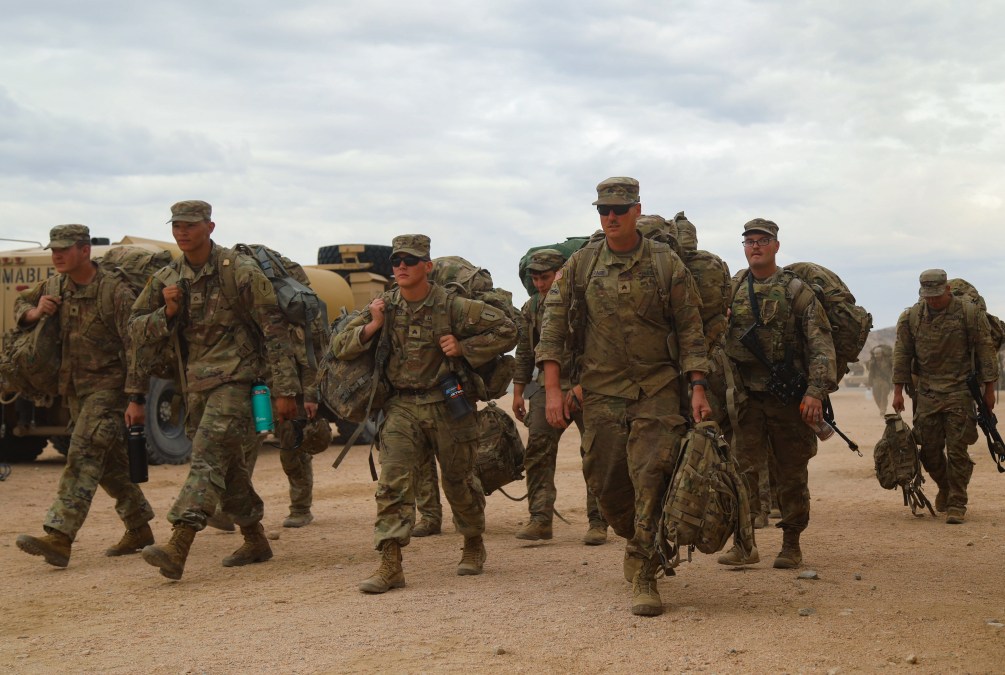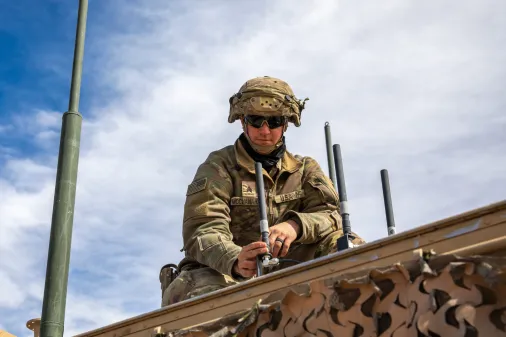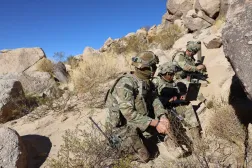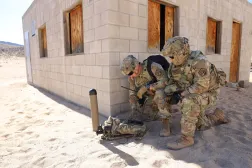Division headquarters will now accompany brigades to combat training center rotations

FORT BRAGG, N.C. — The Army is now beginning to send division headquarters on no notice to accompany brigades to major training events as a means of exercising how the service will fight with larger echelons in future conflicts.
For the past 20 years during the counterinsurgency fight and war on terror, brigade combat teams were the Army’s main unit of action. Now, with the rise of great power competition as well as the Army’s new multidomain doctrine — which directs the Army to combine and integrate land, air, maritime, space and cyber in all facets of operations — the service must be ready to battle more sophisticated adversaries across much longer distances.
This means pushing everything up to higher echelons. As a result, the division is now the unit of action and the Army must figure out how to fight at that level as well as at the corps and even theater levels.
In a way, this is back to the future, given that during the Cold War and prior to 9/11, the Army fought this way. However, much of the force, except top leadership, was too young to recall those days.
“Our level of readiness is moving up to the division. We’ve seen the necessity to build capacity at the battalion into the brigade fight, Afghanistan, Iraq — that multi-echelon training. And that’s what we’ve recognized,” Gen. Andrew Poppas, commander of Forces Command, told DefenseScoop on the sidelines of the service’s recent Scarlet Dragon exercise.
He said a division headquarters is getting ready to accompany one of the brigades of the 3rd Infantry Division for its rotation at the National Training Center at Fort Irwin. Each brigade, as part of its capstone training event to be validated as a fully trained and ready brigade, must go through a combat training center rotation in which they are stressed under a simulated battle campaign.
Now, the Army is set to send a division headquarters on no notice — known as an Emergency Deployment Readiness Exercise (EDRE) — as a means of developing deep attack and exercise functions of multidomain fighting to include non-kinetic capabilities.
“We’ve identified a couple of gaps in terms of expertise. But the division is going to go out there, develop a deep attack, set the conditions for the brigade’s rotation. We didn’t do that before,” Poppas said. “As the brigade is going to get ready for their known rotation out in California, we no-noticed the division: ‘Hey, you’re flying out.’ We alerted [field artillery] battalion, HIMARS battalion, aviation unit and some infantry units and we’re taking them out there and they’re going to develop a deep attack so you’re working all the different domain components so that we can continue to build the capacity at the division.”
Poppas said the Army will continue to no-notice send divisions to combat training center rotations along with brigades going forward.
“By taking them out too early, working those division-level tasks, forcing, again, the ability for that staff to incorporate the multidomain, they’re going to fight in the cyber domain, they’re going to have to incorporate all the space-based capabilities in order to do these long-range attacks,” he said. “The things that you see here in terms of targeting, mapping, sustainment all have to be incorporated off the EDRE. So as we develop multi-echelon, we can’t create more time, but we can better utilize the time we have. So as we’re training the brigade here, we find an opportunity to bring the division out also. We’re starting to work as they get better at all their tasks, if the brigades get better, the battalion, the company and down. But now really focusing on the division because we know that if that’s the unit of action, then they’ve got to be at a level of competency and proficiency in order to support and set conditions for these lower echelons.”
Poppas said that in prior generations, there were far fewer capabilities to be incorporated into the fight. Now, there are space, cyber and other multidomain capabilities the headquarters have to integrate.
“If you haven’t trained on them, if you don’t know the full capacity and their capabilities, then you’re sub-optimized,” Poppas said. “You can read about it, but until you see them in real life and you synchronize them in the fight in time and space, then you’re not going to be effective. That’s what that training does and that’s what we’re bringing to bear.”
While a few gaps in terms of levels of expertise have been identified, especially in the cyber domain, the Army is still building out cyber and electromagnetic activities (CEMA) groups within the staff sections at each echelon. These organizations will seek to advise commanders on courses of action within cyberspace and the electromagnetic spectrum as well as serve as the connection to higher capabilities, such as U.S. Cyber Command.
Additionally, the Army is learning how to scale things at higher echelons.
“Much larger scale, much higher level of accuracy and lethality and not just on the physical domain, but in the cyber domain utilizing space capabilities and you don’t stop at the division, though that’s your main unit of action, your corps acting as a [joint task force] expands out and then your theater army, you’re setting the theater,” Poppas said. “The capacity and the capability to shape the conditions for the future fight … that’s why the division as the unit of action moved up from the brigade because they’ve got a much greater capacity, in terms of warfighting capabilities, in their fires, their range, their visibility, every unit can’t do the same thing,” Poppas said.
There is a chain reaction in which the battalion informs the brigade, the brigade informs the division and the division feeds up to the corps or joint task force. As they elevate up, they can start looking at different ranges to influence, which is where the division is ultimately going to have to apply these capabilities, Poppas said.






